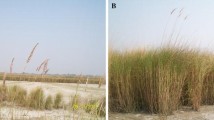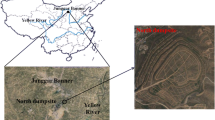Abstract
Proliferation of fly ash (FA) deposits and its toxicity have become a global concern, which contaminate the ecosystems of our Earth. In this regard, identification of potential plant species for FA deposits’ restoration is the main concern. Keeping this view in mind, the present study was conducted to identify potential plant species naturally growing on FA deposits for the restoration purposes. Six intensive surveys were made during 2010–2014 to collect naturally growing plant species during different seasons from two FA deposits in Unchahar of Raebareli district, Uttar Pradesh, India. The plant species having potential for FA deposits’ restoration were identified on the basis of their ecological importance, dominance at the study sites and socio-economic importance for rural livelihoods. Typha latifolia L., Cynodon dactylon (L.) Pers., Saccharum spontaneum L., Saccharum bengalense Retz. (syn. Saccharum munja), Prosopis juliflora (Sw.) DC., Ipomoea carnea Jacq. and Acacia nelotica L. are identified as potential plant species for FA deposits’ restoration. Furthermore, the characteristics of naturally colonized species can be used for the phytorestoration during a revegetation plan of new FA deposits for multiple benefits.




Similar content being viewed by others
References
Babcock MF, Evans DW, Albert JJ (1983) Comparative uptake and translocation of trace elements from coal ash by Typha latifolia. Sci Total Environ 28:203–214
Babu AG, Reddy MS (2011) Dual inoculation of arbuscular mycorrhizal and phosphate solubilizing fungi contributes in sustainable maintenance of plant health in fly ash ponds. Water Air Soil Pollut 219:3–10
Bajpai O, Kumar A, Mishra AK, Sahu N, Pandey J, Behera SK, Chaudhary LB (2012) Recongregation of tree species of Katerniaghat wildlife sanctuary, Uttar Pradesh, India. J Biodivers Environ Sci 2(12):24–40
Chiu KK, Ye ZH, Wong MH (2006) Growth of Veteveria zizanoides and Phragmites australis on Pb/Zn and Cu mine tailings amendment with manure compost and sewage sludge: a green house study. Bioresour Technol 97:158–170
Chu LM (2008) Natural revegetation of coal fly ash in a highly saline disposal lagoon in Hong Kong. Appl Veg Sci 11:297–306
Connell JH, Slatyer RO (1977) Mechanisms of succession in natural communities and their role in community stability and organization. Am Nat 111:1119–1144
Curtis JT, McIntosh RP (1950) The interrelations of certain analytic and synthetic phytosociological characters. Ecology 31(3):434–455
Dellantonio A, Fitz WJ, Repmann F, Wenzel WW (2009) Disposal of coal combustion residues in terrestrial systems: contamination and risk management. J Environ Qual 39(3):761–775
Duthie JF (1960) Flora of upper Gangatic plain and of the adjacent Shiwalic and Sub-Himalayan Trct, 2 vol. Rep. Edi. Botanical Survey of India, Calcutta
FAU (2013) Fly ash utilisation – 2nd Annual International Summit. http://flyash2012.missionenergy.org/index.html. Accessed 10 Aug 2014
Greenwood EF, Gemmill RP (1978) Derelict industrial land as a habitat for rare plants in S. Lancs (v.c. 59) and W. Lancs (v.c. 60). Watsonia 12:33–40
Gupta AK, Sinha S (2008) Decontamination and/or revegetation of fly ash dykes through naturally growing plants. J Hazard Mater 153:1078–1087
Hall A (2005) The plant community of Bergen swamp, NY, a rich minerotrophic mire. In: The environ-mental gradients and plant communities of Bergen swamp, NY, USA. Thesis Report, Rochester Institute of Technology, New York. https://ritdml.rit.edu/bitstream/handle/1850/1121/AHallThesis2005.pdf?sequence=8. Accessed 10 Aug 2014
Hammer Ø, Harper DAT, Ryan DP (2001) PAST: paleontological statistics software package for education and data analysis. Palaeontol Electron 4(1):9
Haynes RJ (2009) Reclamation and revegetation of fly ash disposal sites – challenges and research needs. J Environ Manage 90:43–53
Hrynkiewiez K, Baum C, Niedojadlo J, Dahm H (2009) Promotion of mycorrhiza formation and growth of willows by the bacterial strain Sphingomonas sp. 23L on fly ash. Biol Fertil Soils 45:385–394
Jain SK (1968) Medicinal plants. National Book Trust, New Delhi
Jambhulkar HP, Juwarkar AA (2009) Assessment of bioaccumulation of heavy metals by different plant species grown on fly ash dump. Ecotoxicol Environ Saf 72:1122–1128
Juwarkar AA, Jambhulkar HP (2008) Restoration of fly ash dumps through biological interventions. Environ Monit Assess 139:355–365
Kanjilal PC (1933) Forest flora of Pilibhit, Oudha, Gorakhpur and Bundelkhand. Govt. Printing Press, Allahabad
Krzaklewski W, Pietrzykowski M, Wos B (2012) Survival and growth of alders (Alnus glutinosa (L.) Gaertn. and Alnus incana (L.) Moench) on fly ash technosols at different substrate improvement. Ecol Eng 49:35–40
Kumar A (2005) Ethnobotanical aspects of pharmacological flora used by Tharu Tribes in Tarai belt of Northeastern Uttar Pradesh. Ph. D. Thesis, Dr. RML Avadh University, Faizabad
Kumari A, Pandey VC, Rai UN (2013) Feasibility of fern Thelypteris dentata for revegetation of coal fly ash landfills. J Geochem Explor 128:147–152
Love A, Tandon R, Banerjee BD, Babu CR (2009) Comparative study on elemental composition and DNA damage in leaves of a weedy plant species, Cassia occidentalis, growing wild on weathered fly ash and soil. Ecotoxicology 18:791–801
Luken JO (1990) Directing ecological succession. Chapman and Hall, London
Maiti SK, Nandhini S (2006) Bioavailability of metals in fly ash and their bioaccumulation in naturally occurring vegetation: a pilot scale study. Environ Monit Assess 116: 263–273
Maiti SK, Jaiswal S (2008) Bioaccumulation and translocation of metals in the natural vegetation growing on fly ash deposits: a field study from Santaldih thermal power plant, West Bengal, India. Environ Monit Assess 136:355–370
Maiti SK, Singh G, Srivastava SB (2005) Study of the possibility of utilizing fly ash for back filling and reclamation of opencast mines: plot and pot scale experiments with Chandrapura FA. In International Congress on Fly Ash, TIFAC, 4–7th December 2005, New Delhi
Mishra BK, Verma VK (1992) Flora of Allahabad district Utter Pradesh, India. Bishen Singh Mahendra Pal Singh, Dehradoon
Morton JF (1975) Cattails (Typha spp.)–weed problem or potential crop? Econ Bot 29:7–29
Mulhern DW, Robel RJ, Furness JC, Hensley DL (1989) Vegetation of waste disposal area at a coal fired power (plants) on fly ash. Environ Sci Technol 13:311–315
Mustafa B, Hajdari A, Krasniqi F, Morina I, Riesbeck F, Sokoli A (2012) Vegetation of the ash dump of the “Kosova A” power plant and the slag dump of the “Ferronikeli” Smelter in Kosovo. Res J Environ Earth Sci 4(9):823–834
Myster RW, Pickett STA (1994) A comparison of rate of succession over 18 yr in 10 contrasting old fields. Ecology 75:387–392
Pandey VC (2012a) Phytoremediation of heavy metals from fly ash pond by Azolla caroliniana. Ecotoxicol Environ Saf 82:8–12
Pandey VC (2012b) Invasive species based efficient green technology for phytoremediation of fly ash deposits. J Geochem Explor 123:13–18
Pandey VC (2013) Suitability of Ricinus communis L. cultivation for phytoremediation of fly ash disposal sites. Ecol Eng 57:336–341
Pandey VC, Kumar A (2012) Leucaena leucocephala: an underutilized plant for pulp and paper production. Genet Resour Crop Ev 60:1165–1171
Pandey VC, Singh N (2010) Impact of fly ash incorporation in soil systems. Agric Ecosyst Environ 136:16–27
Pandey VC, Singh K (2011) Is Vigna radiata suitable for the revegetation of fly ash landfills? Ecol Eng 37:2105–2106
Pandey VC, Singh B (2012) Rehabilitation of coal fly ash basins: current need to use ecological engineering. Ecol Eng 49:190–192
Pandey VC, Abhilash PC, Singh N (2009a) The Indian perspective of utilizing fly ash in phytoremediation, phytomanagement and biomass production. J Environ Manage 90:2943–2958
Pandey VC, Abhilash PC, Upadhyay RN, Tewari DD (2009b) Application of fly ash on the growth performance, translocation of toxic heavy metals within Cajanus cajan L.: implication for safe utilization of fly ash for agricultural production. J Hazard Mater 166:255–259
Pandey VC, Singh JS, Kumar A, Tewari DD (2010) Accumulation of heavy metal by chickpea grown in fly ash treated soil: effect on antioxidants. CLEAN – Soil Air Water 38:1116–1123
Pandey VC, Singh JS, Singh RP, Singh N, Yunus M (2011) Arsenic hazards in coal fly ash and its fate in Indian scenario. Resour Conserv Recy 55:819–835
Pandey VC, Singh K, Singh RP, Singh B (2012) Naturally growing Saccharum munja on the fly ash lagoons: a potential ecological engineer for the revegetation and stabilization. Ecol Eng 40:95–99
Pietrzykowski M, Krzaklewski W, Gaik G (2010) Assessment of forest growth with plantings dominated by Scots pine (Pinus sylvestris L.) on experimental plots on a fly ash disposal site at the Bełchatow power plant. Environ Eng 137(17):65–74 (In Polish, English summary)
Rai UN, Pandey K, Sinha S, Singh A, Saxena R, Gupta DK (2004) Revegetating fly ash landfills with Prosopis juliflora L.: impact of different amendments and Rhizobium inoculation. Environ Int 30:293–300
Rau N, Mishra V, Sharma M, Das MK, Ahaluwalia K, Sharma RS (2009) Evaluation of functional diversity in rhizobacterial taxa of a wild grass (Saccharum ravennae) colonizing abandoned fly ash dumps in Delhi urban ecosystem. Soil Biol Biochem 41:813–821
Ray P, Adholeya A (2009) Correlation between organic acid exudation and metal uptake by ectomycorrhizal fungi grown on pond ash in vitro. Biometals 22:275–281
Ruhl L, Vengosh A, Dwyer GS, Hsu-Kim H, Deonarine A (2010) Environmental impacts of the coal ash spill in Kingston, Tennessee: an 18-month survey. Environ Sci Technol 44:9272–9278
Selvam A, Mahadevan A (2002) Distribution of mycorrhizas in an abandoned fly ash pond and mined sites of Neyveli Lignite Corporation, Tamil Nadu, India. Basic Appl Ecol 3:277–284
Sharma M, Rau N, Mishra V, Sharma RS (2005) Unexplored ecological significance of Saccharum munja. Species 43:22
Sharma M, Mishra V, Rau N, Sharma RS (2011) Functionally diverse rhizobacteria of Saccharum munja (a native wild grass) colonizing abandoned morrum mine in Aravalli hills (Delhi). Plant Soil 341:447–459
Shaw PJA (1992) A preliminary study of successional changes in vegetation and soil development on unamended fly ash (PFA) in southern England. J Appl Ecol 29:728–736
Shaw PJA (1994) Orchid woods and floating islands - the ecology of fly ash. Br Wildl 5:149–157
Singh JS, Pandey VC (2013) Fly ash application in nutrient poor agriculture soils: impact on methanotrophs population dynamics and paddy yields. Ecotoxicol Environ Saf 89:43–51
Singh D, Chhonkar PK, Dwivedi BS (2007) Soil analysis. In: Manual on soil, plant and water analysis. Westville Publishing House, Delhi, p 11–75
Singh JS, Pandey VC, Singh DP (2011) Coal fly ash and farmyard manure amendments in dry-land paddy agriculture field: effect on N-dynamics and paddy productivity. Appl Soil Ecol 47:133–140
Singh K, Pandey VC, Singh B, Patra DD, Singh RP (2013) Effect of fly ash on crop yield and physico-chemical, microbial and enzyme activities of sodic soils. Environ Eng Manag J. http://omicron.ch.tuiasi.ro/EEMJ/pdfs/accepted/264_716_Singh_12.pdf
Tiwari S, Kumari B, Singh SN (2008) Evaluation of metal mobility/immobility in fly ash induced by bacterial strains isolated from the rhizospheric zone of Typha latifolia growing on fly ash dumps. Bioresour Technol 99:1305–1310
US EPA (2007) Human and ecological risk assessment of coal combustion wastes. US EPA (draft)
Vance ED, Brookes PC, Jenkinson DS (1987) An extraction method for measuring soil microbial biomass C. Soil Biol Biochem 19:703–707
Walkley A, Black IA (1934) An examination of the Degtjareff method for determining organic carbon in soils: effect of variations in digestion conditions and of inorganic soil constituents. Soil Sci 63:251–263
Wong MH (2003) Ecological restoration of mine degraded soils with emphasis on metal contaminated soils. Chemosphere 50:775–780
Yoon J, Cao X, Zhou Q, Ma LQ (2006) Accumulation of Pb Cu and Zn in native plants growing on a contaminated Florida site. Sci Total Environ 368:456–464
Acknowledgments
The authors would like to thank the fly ash deposit observer Bansilal for access to the ash dumping sites. Financial assistance given to Dr. VC Pandey as Young Scientist under Fast Track Scheme (No. SR/FTP/ES-96/2012) by the Science and Engineering Research Board (SERB), Department of Science and Technology (DST), Government of India, New Delhi, is gratefully acknowledged. The author is also thankful to Dr. C.S. Nautiyal, Director, CSIR-National Botanical Research Institute, Lucknow, for his kind support.
Conflicts of interest
The authors declare no conflicts of interest.
Author information
Authors and Affiliations
Corresponding author
Additional information
Responsible editor: Philippe Garrigues
Rights and permissions
About this article
Cite this article
Pandey, V.C., Prakash, P., Bajpai, O. et al. Phytodiversity on fly ash deposits: evaluation of naturally colonized species for sustainable phytorestoration. Environ Sci Pollut Res 22, 2776–2787 (2015). https://doi.org/10.1007/s11356-014-3517-0
Received:
Accepted:
Published:
Issue Date:
DOI: https://doi.org/10.1007/s11356-014-3517-0




